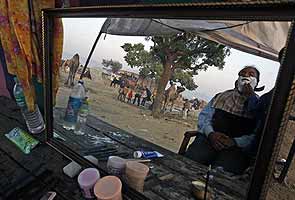A report of the Associate Press appearing on the Internet site of India’s NDTV.com (October 6, 2013), says:
File pic: A man gets during the annual cattle fair in Pushkar, Rajasthan. Photo: Associated Press. Coutsey: NDTV.com
New York: Procter & Gamble executives say it was striking the first time they witnessed a man shave while sitting barefoot on the floor in a tiny hut in India.
He had no electricity, no running water and no mirror.
The 20 US-based executives observed the man in 2008 during one of 300 visits they made to homes in rural India. The goal? To gain insights they could use to develop a new razor for India.
“That, for me, was a big ‘a-ha,'” said Alberto Carvalho, vice president, global Gillette, a unit of P&G. “I had never seen people shaving like that.”
The visits kicked off the 18 months it took to develop Gillette Guard, a low-cost razor designed for India and other emerging markets. Introduced three years ago, Guard quickly gained market share and today represents two out of every three razors sold in India. The story of how Guard came to be illustrates the balance companies must strike when creating products for emerging markets: It’s not as simple as slapping a foreign label on an American product. […]
 This report also underlines the “lead market” function of India for frugal innovations that has been researched by our team and has been dealt with in greater detail in our forthcoming book “Aiming Big with Small Cars: Emergence of a Lead Market in India” (Springer). We are organizing a symposium on frugal innovations to cover upcoming key questions on global growth in both emerging as well as developed markets through affordable and good-enough solutions and to disseminate the results of our research. Meanwhile interested readers might like to read our article “Assessing India’s lead market potential for cost-effective innovations“, published in the Journal of Indian Business Research.
This report also underlines the “lead market” function of India for frugal innovations that has been researched by our team and has been dealt with in greater detail in our forthcoming book “Aiming Big with Small Cars: Emergence of a Lead Market in India” (Springer). We are organizing a symposium on frugal innovations to cover upcoming key questions on global growth in both emerging as well as developed markets through affordable and good-enough solutions and to disseminate the results of our research. Meanwhile interested readers might like to read our article “Assessing India’s lead market potential for cost-effective innovations“, published in the Journal of Indian Business Research.

